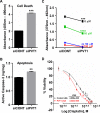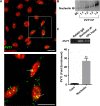The lncRNA PVT1 Contributes to the Cervical Cancer Phenotype and Associates with Poor Patient Prognosis
- PMID: 27232880
- PMCID: PMC4883781
- DOI: 10.1371/journal.pone.0156274
The lncRNA PVT1 Contributes to the Cervical Cancer Phenotype and Associates with Poor Patient Prognosis
Abstract
The plasmacytoma variant translocation 1 gene (PVT1) is an lncRNA that has been designated as an oncogene due to its contribution to the phenotype of multiple cancers. Although the mechanism by which PVT1 influences disease processes has been studied in multiple cancer types, its role in cervical tumorigenesis remains unknown. Thus, the present study was designed to investigate the role of PVT1 in cervical cancer in vitro and in vivo. PVT1 expression was measured by quantitative PCR (qPCR) in 121 invasive cervical carcinoma (ICC) samples, 30 normal cervix samples, and cervical cell lines. Functional assays were carried out using both siRNA and LNA-mediated knockdown to examine PVT1's effects on cervical cancer cell proliferation, migration and invasion, apoptosis, and cisplatin resistance. Our results demonstrate that PVT1 expression is significantly increased in ICC tissue versus normal cervix and that higher expression of PVT1 correlates with poorer overall survival. In cervical cancer cell lines, PVT1 knockdown resulted in significantly decreased cell proliferation, migration and invasion, while apoptosis and cisplatin cytotoxicity were significantly increased in these cells. Finally, we show that PVT1 expression is augmented in response to hypoxia and immune response stimulation and that this lncRNA associates with the multifunctional and stress-responsive protein, Nucleolin. Collectively, our results provide strong evidence for an oncogenic role of PVT1 in cervical cancer and lend insight into potential mechanisms by which PVT1 overexpression helps drive cervical carcinogenesis.
Conflict of interest statement
Figures





Similar articles
-
C-Myc-activated long non-coding RNA PVT1 enhances the proliferation of cervical cancer cells by sponging miR-486-3p.J Biochem. 2020 Jun 1;167(6):565-575. doi: 10.1093/jb/mvaa005. J Biochem. 2020. PMID: 31943014
-
Long non‑coding RNA plasmacytoma variant translocation 1 gene promotes the development of cervical cancer via the NF‑κB pathway.Mol Med Rep. 2019 Sep;20(3):2433-2440. doi: 10.3892/mmr.2019.10479. Epub 2019 Jul 9. Mol Med Rep. 2019. PMID: 31322217
-
Expression of the lncRNA ZFAS1 in cervical cancer and its correlation with prognosis and chemosensitivity.Gene. 2019 May 15;696:105-112. doi: 10.1016/j.gene.2019.01.025. Epub 2019 Feb 7. Gene. 2019. PMID: 30738960
-
PVT1 lncRNA in lung cancer: A key player in tumorigenesis and therapeutic opportunities.Pathol Res Pract. 2024 Jan;253:155019. doi: 10.1016/j.prp.2023.155019. Epub 2023 Dec 7. Pathol Res Pract. 2024. PMID: 38091883 Review.
-
Long noncoding RNA PVT1: A highly dysregulated gene in malignancy.J Cell Physiol. 2020 Feb;235(2):818-835. doi: 10.1002/jcp.29060. Epub 2019 Jul 11. J Cell Physiol. 2020. PMID: 31297833 Review.
Cited by
-
Involvement of Long Non-Coding RNAs (lncRNAs) in Tumor Angiogenesis.Noncoding RNA. 2020 Sep 25;6(4):42. doi: 10.3390/ncrna6040042. Noncoding RNA. 2020. PMID: 32992718 Free PMC article. Review.
-
lncRNA PVT1: a novel oncogene in multiple cancers.Cell Mol Biol Lett. 2022 Oct 4;27(1):84. doi: 10.1186/s11658-022-00385-x. Cell Mol Biol Lett. 2022. PMID: 36195846 Free PMC article. Review.
-
Long noncoding RNA plasmacytoma variant translocation 1 promotes progression of colorectal cancer by sponging microRNA-152-3p and regulating E2F3/MAPK8 signaling.Cancer Sci. 2022 Jan;113(1):109-119. doi: 10.1111/cas.15113. Epub 2021 Nov 24. Cancer Sci. 2022. PMID: 34418232 Free PMC article.
-
Long Noncoding RNA PVT1 Facilitates Cervical Cancer Progression via Negative Regulating of miR-424.Oncol Res. 2017 Sep 21;25(8):1391-1398. doi: 10.3727/096504017X14881559833562. Epub 2017 Mar 8. Oncol Res. 2017. PMID: 28276314 Free PMC article.
-
High expression of lncRNA PVT1 independently predicts poor overall survival in patients with primary uveal melanoma.PLoS One. 2017 Dec 15;12(12):e0189675. doi: 10.1371/journal.pone.0189675. eCollection 2017. PLoS One. 2017. PMID: 29244840 Free PMC article.
References
-
- Prensner JR, Chinnaiyan AM (2011) The emergence of lncRNAs in cancer biology. Cancer Discov 1: 391–407. 10.1158/2159-8290.CD-11-0209 - DOI - PMC - PubMed
-
- TCGA Research Network.
-
- Webb E, Adams JM, Cory S (1984) Variant (6; 15) translocation in a murine plasmacytoma occurs near an immunoglobulin kappa gene but far from the myc oncogene. Nature 312: 777–779. - PubMed
MeSH terms
Substances
Grants and funding
LinkOut - more resources
Full Text Sources
Other Literature Sources
Medical

